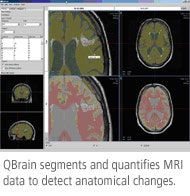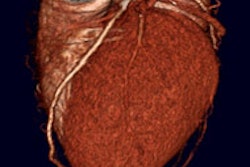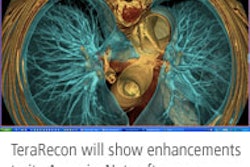Dutch software developer Medis will highlight a range of new analytical software applications, from a brain quantification program to orthopedic templating software.
QBrain is a new application that segments and quantifies MRI data, enabling users to track morphological changes, such as the growth of white matter lesions or the volume of the hippocampus, that can be indicators of the onset of disease, according to the company. FDA clearance is pending and the software will be available in the U.S. and worldwide in the first quarter of 2005.

MRA-CMS is an application that automatically segments and quantifies stenoses in straight peripheral vessels based on automatic contour detection techniques from 3D MRA datasets. The software provides information about the stenosis itself, as well as the complete vessel segment. MRA-CMS is available now on a standalone basis and will be available as an application integrated into a PACS network in the first quarter of 2005.
QCU-CMS 1.0 enables quantification of intravascular ultrasound (IVUS) studies through the semiautomated detection of the lumen, stent, and vessel contours. The technique can measure plaque volume, subsegmental data, and other clinically relevant parameters. The software has 510(k) clearance and is available worldwide.
QCA-CMS 6.0 enables users to conduct automatic stenosis quantification in coronary artery angiography, with options for drug-eluting stent analysis and brachytherapy. The company has added new features that include subsegmental analysis for assessing angiographic parameters in multiple subsequent subsegments in the vessel of interest. The software also now supports the simultaneous review of different coronary angiography runs of a patient in multiple windows. The application has FDA clearance and is available worldwide.
QVA-CMS 6.0 is a new analytical software package for the automated stenosis quantification of peripheral arteries on standard digital, subtracted, or inverted images. Depending on vessel morphology, three model analyses are available: for straight vessels, ostial lesions, and bifurcations. The software has 510(k) clearance and is available worldwide.
Finally, Ortho-CMS is a digital templating software application for orthopedic surgeons. The software consists of modules that perform different analyses on orthopedic images, either preoperatively or postoperatively. In preoperative mode, users can conduct surgical planning using templates from major orthopedic device manufacturers, and can also perform basic measurements. Postoperative applications include measuring distances and angles of bony structures and prostheses. Ortho-CMS has 510(k) clearance and is available worldwide.
By Brian Casey
AuntMinnie.com staff writer
November 18, 2004
Copyright © 2004 AuntMinnie.com



















